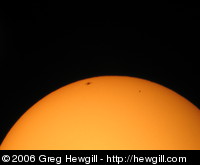The weather was good to us this morning and I was able to get some pictures of the transit of Mercury. As in the photo on the right, Mercury is the small round dot on the right, not the larger irregular blob on the left which is a sunspot.
The photos really don't do it justice. It's so much crisper when you look through the eyepiece with your own eyes - Mercury is a small black disk, and you can see light and structure in the sunspot.
This was the first time I'd set up my telescope in a long time (probably since taking partial solar eclipse photos a year and a half ago). We got a T-adapter to connect Amy's Canon Rebel to the telescope, which appears to connect fine. However, I wasn't quite able to get the camera close enough to the focal plane of the telescope to focus correctly. I'm guessing it needs to be just a few millimetres closer to be in the focal plane. So, we weren't able to get any pictures that way. I had to make do with my usual technique of holding up my digital camera to the eyepiece and snapping photos.
It's now clouded over and solar observation is probably done for the day. I'm glad we were able to get the photos we did!
2006-11-08T22:09:10Z
2006-11-08T22:47:15Z
Now, a hydrogen-alpha filter would be really cool and you would be able to see coronal effects. But those are really $$$.

2006-11-08T22:01:53Z